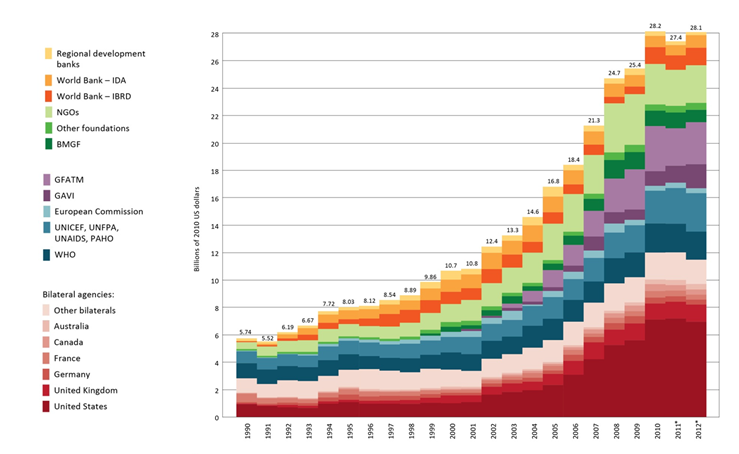It's been called the "largest clinical* trial ever": DEVTA (Deworming and Enhanced ViTamin A supplementation), a study of Vitamin A supplementation and deworming in over 2 million children in India, just published its results. "DEVTA" may mean "deity" or "divine being" in Hindi but some global health experts and advocates will probably think these results come straight from the devil. Why? Because they call into question -- or at least attenuate -- our estimates of the effectiveness of some of the easiest, best "bang for the buck" interventions out there.
Data collection was completed in 2006, but the results were just published in The Lancet. Why the massive delay? According to the accompany discussion paper, it sounds like the delay was rooted in very strong resistance to the results after preliminary outcomes were presented at a conference in 2007. If it weren't for the repeated and very public shaming by the authors of recent Cochrane Collaboration reviews, we might not have the results even today. (Bravo again, Cochrane.)
So, about DEVTA. In short, this was a randomized 2x2 factorial trial, like so:

The results were published as two separate papers, one on Vitamin A and one on deworming, with an additional commentary piece:
The controversy is going to be more about what this trial didn't find, rather than what they did: the confidence interval on the Vitamin A study's mortality estimate (mortality ratio 0.96, 95% confidence interval of 0.89 to 1.03) is consistent with a mortality reduction as large as 11%, or as much as a 3% increase. The consensus from previous Vitamin A studies was mortality reductions of 20-30%, so this is a big surprise. Here's the abstract to that paper:
Background
In north India, vitamin A deficiency (retinol <0·70 μmol/L) is common in pre-school children and 2–3% die at ages 1·0–6·0 years. We aimed to assess whether periodic vitamin A supplementation could reduce this mortality.
Methods
Participants in this cluster-randomised trial were pre-school children in the defined catchment areas of 8338 state-staffed village child-care centres (under-5 population 1 million) in 72 administrative blocks. Groups of four neighbouring blocks (clusters) were cluster-randomly allocated in Oxford, UK, between 6-monthly vitamin A (retinol capsule of 200 000 IU retinyl acetate in oil, to be cut and dripped into the child’s mouth every 6 months), albendazole (400 mg tablet every 6 months), both, or neither (open control). Analyses of retinol effects are by block (36 vs36 clusters).
The study spanned 5 calendar years, with 11 6-monthly mass-treatment days for all children then aged 6–72 months. Annually, one centre per block was randomly selected and visited by a study team 1–5 months after any trial vitamin A to sample blood (for retinol assay, technically reliable only after mid-study), examine eyes, and interview caregivers. Separately, all 8338 centres were visited every 6 months to monitor pre-school deaths (100 000 visits, 25 000 deaths at ages 1·0–6·0 years [the primary outcome]). This trial is registered at ClinicalTrials.gov, NCT00222547.
Findings
Estimated compliance with 6-monthly retinol supplements was 86%. Among 2581 versus 2584 children surveyed during the second half of the study, mean plasma retinol was one-sixth higher (0·72 [SE 0·01] vs 0·62 [0·01] μmol/L, increase 0·10 [SE 0·01] μmol/L) and the prevalence of severe deficiency was halved (retinol <0·35 μmol/L 6% vs13%, decrease 7% [SE 1%]), as was that of Bitot’s spots (1·4% vs3·5%, decrease 2·1% [SE 0·7%]).
Comparing the 36 retinol-allocated versus 36 control blocks in analyses of the primary outcome, deaths per child-care centre at ages 1·0–6·0 years during the 5-year study were 3·01 retinol versus 3·15 control (absolute reduction 0·14 [SE 0·11], mortality ratio 0·96, 95% CI 0·89–1·03, p=0·22), suggesting absolute risks of death between ages 1·0 and 6·0 years of approximately 2·5% retinol versus 2·6% control. No specific cause of death was significantly affected.
Interpretation
DEVTA contradicts the expectation from other trials that vitamin A supplementation would reduce child mortality by 20–30%, but cannot rule out some more modest effect. Meta-analysis of DEVTA plus eight previous randomised trials of supplementation (in various different populations) yielded a weighted average mortality reduction of 11% (95% CI 5–16, p=0·00015), reliably contradicting the hypothesis of no effect.
Note that instead of just publishing these no-effect results and leaving the meta-analysis to a separate publication, the authors go ahead and do their own meta-analysis of DEVTA plus previous studies and report that -- much attenuated, but still positive -- effect in their conclusion. I think that's a fair approach, but also reveals that the study's authors very much believe there are large Vitamin A mortality effects despite the outcome of their own study!
[The only media coverage I've seen of these results so far comes from the Times of India, which includes quotes from the authors and Abhijit Banerjee.]
To be honest, I don't know what to make of the inconsistency between these findings and previous studies, and am writing this post in part to see what discussion it generates. I imagine there will be more commentaries on these findings over the coming months, with some decrying the results and methodologies and others seeing vindication in them. In my view the best possible outcome is an ongoing concern for issues of external validity in biomedical trials.
What do I mean? Epidemiologists tend to think that external validity is less of an issue in randomized trials of biomedical interventions -- as opposed to behavioral, social, or organizational trials -- but this isn't necessarily the case. Trials of vaccine efficacy have shown quite different efficacy for the same vaccine (see BCG and rotavirus) in different locations, possibly due to differing underlying nutritional status or disease burdens. Our ability to interpret discrepant findings can only be as sophisticated as the available data allows, or as sophisticated as allowed by our understanding of the biological and epidemiologic mechanisms that matter on the pathway from intervention to outcome. We can't go back in time and collect additional information (think nutrition, immune response, baseline mortality, and so forth) on studies far in the past, but we can keep such issues in mind when designing trials moving forward.
All that to say, these results are confusing, and I look forward to seeing the global health community sort through them. Also, while the outcomes here (health outcomes) are different from those in the Kremer deworming study (education outcomes), I've argued before that lack of effect or small effects on the health side should certainly influence our judgment of the potential education outcomes of deworming.
*I think given the design it's not that helpful to call this a 'clinical' trial at all - but that's another story.









